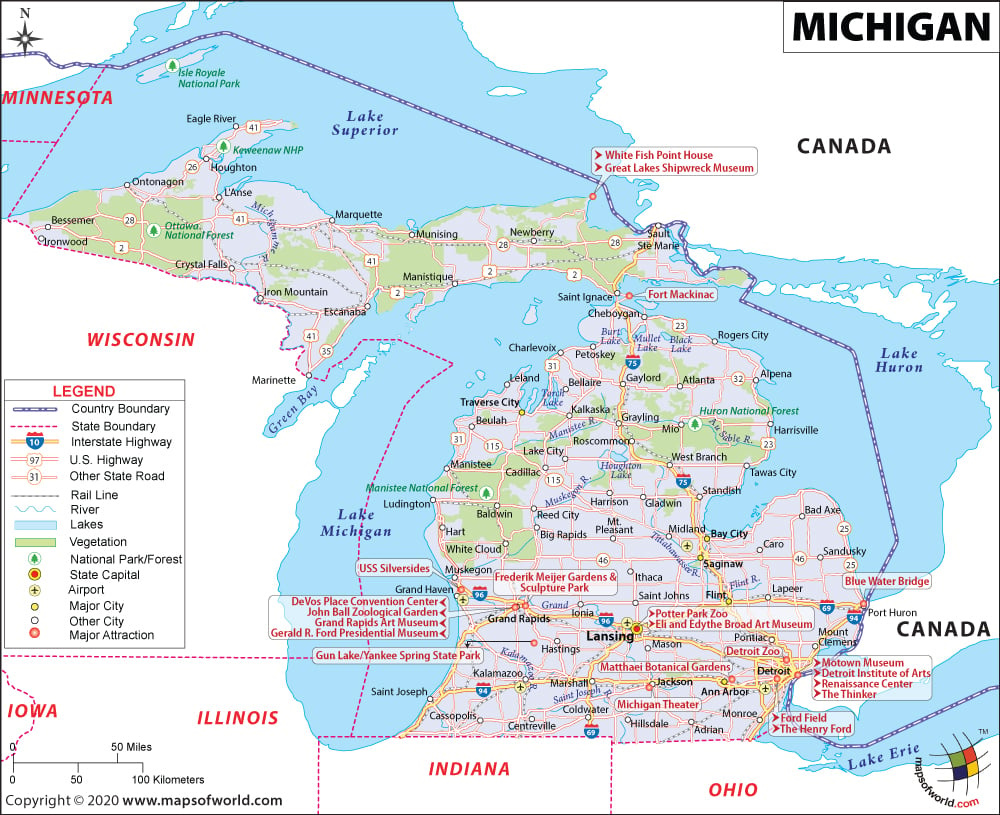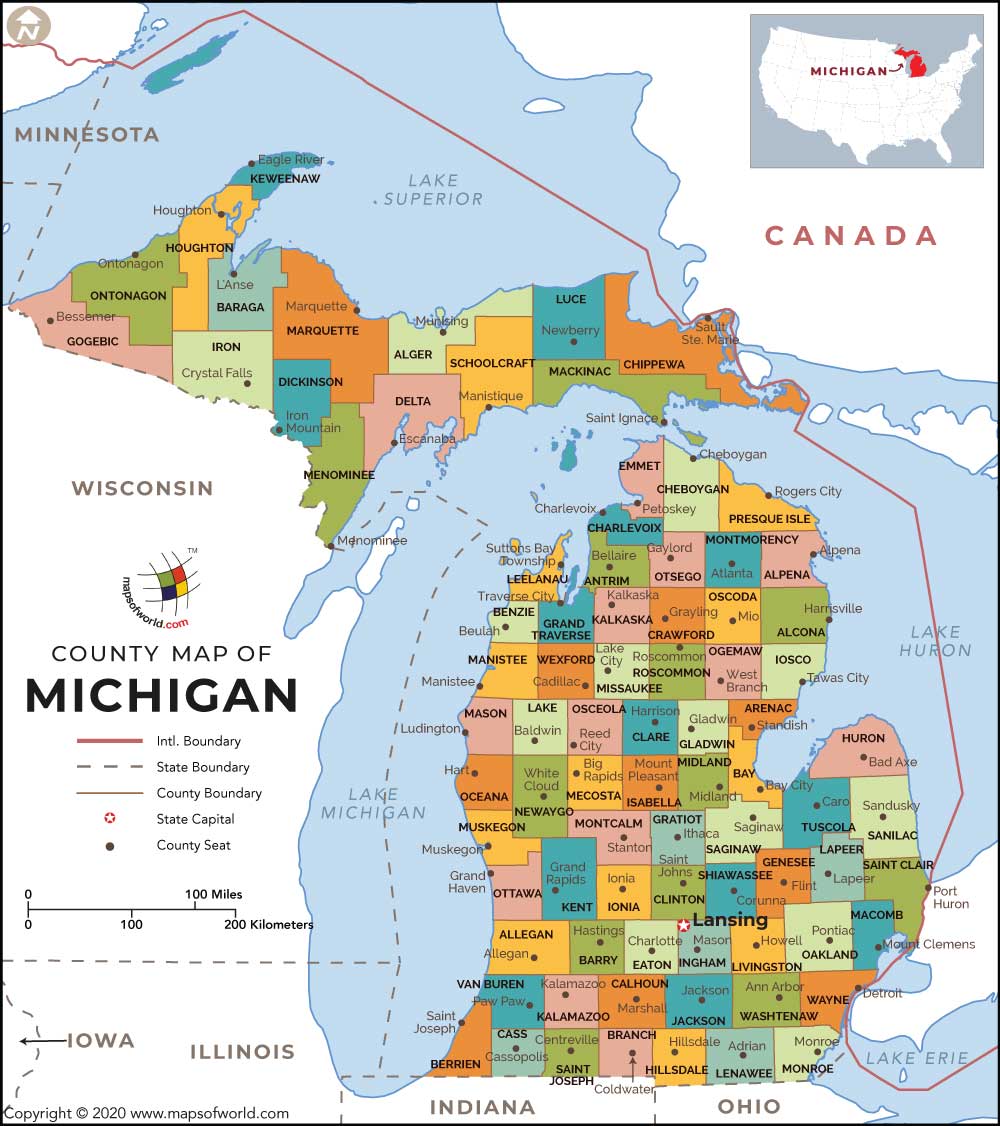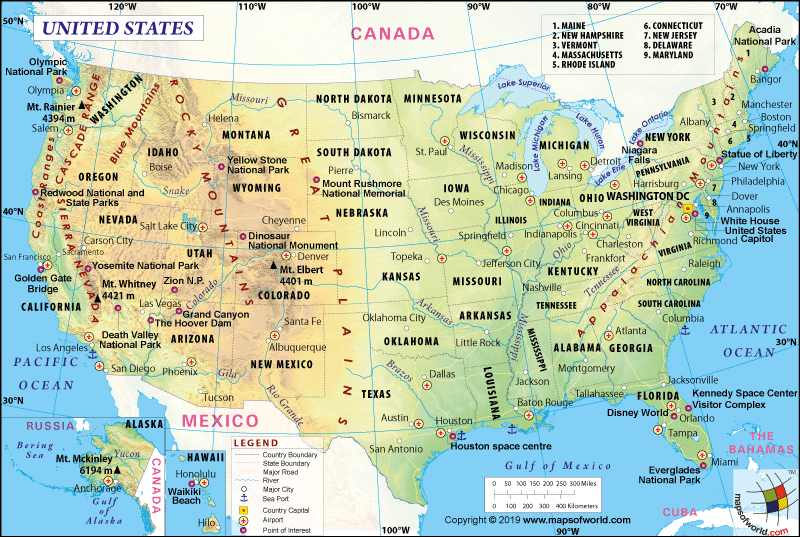What are the Key Facts of Michigan?

|
State |
Michigan |
|
State Capital |
Lansing |
|
Largest City |
Detroit |
|
Coordinates |
44°N 85°W |
|
Nickname(s) |
“The Great Lake(s) State”, “The Wolverine State”, “The Mitten State”, “Water (Winter) Wonderland” |
|
Postal Abbreviation |
MI |
|
Area |
96,716 sq. mi (250,493 sq. km) |
|
Highest Point |
Mount Arvon, 1,979 ft (603 m) |
|
Number of Counties |
83 |
|
Neighboring States |
Ohio, Indiana, Wisconsin |
|
Population |
9,986,857 (2010) |
|
Date of Entering the Union |
January 26, 1837 |
|
State Anthem |
“My Michigan” |
|
Governor |
Gretchen Whitmer (Democratic Party) |
|
Lieutenant Governor |
Garlin Gilchrist (Democratic Party) |
|
U.S. Senators |
Debbie Stabenow (Democratic Party), Gary Peters (Democratic Party) |
|
U.S. House Delegation |
7 Democrats, 6 Republicans, 1 Independent |
|
GDP (Millions of Dollars) |
527096 |
|
Demonym |
Michigander, Michiganian, Yooper (for residents of the Upper Peninsula) |
|
Time Zones |
most of state UTC-05:00 (Eastern), Summer (DST) UTC-04:00 (EDT); 4 U.P. counties (Gogebic, Iron, Dickinson, and Menominee) UTC-06:00 (Central), Summer (DST) UTC-05:00 (CDT) |
Where is Michigan?
Michigan is a state in the Great Lakes and Midwestern regions of the USA. Michigan has two separate peninsulas: the Upper Peninsula and Lower Peninsula.
The Upper Peninsula shares its border with Lake Superior on the north and Lake Michigan and Lake Huron on the south. This peninsula also shares its border with neighboring Wisconsin to the west. The Lower Peninsula is located between Lake Erie, Lake Huron and Lake Michigan. It shares its borders with Ohio and Indiana to the south, and a five-mile (8 km) long Mackinac Bridge connects the two peninsulas.
What is the Geography of Michigan?
Michigan is spread across a total area of 96,716 sq. km (250,493 sq. mi), making it the 11th largest state among the 50 states of the US. To the east of the Mississippi River, it is the largest state. Out of the total area, 56,539 sq. km (146,435 sq. mi) is land area and 40,175 sq. km (104,052 sq. mi) is water area.
At the most distant points, Michigan is 490 mi (788.6 km) long and 240 mi (386.2 km) wide. As there are two land areas of the state, the total coastline is around 3,288 mi (5,291.5 km) long, the second largest coastline after Alaska.
The mean elevation of the state is 900 ft (274.3 m) above sea level. While the highest elevation point is Mount Arvon at 1,979 ft (603.2 m) above sea level, the lowest elevation point is at the point (572 ft or 172.3 m above sea level) where Michigan meets Lake Erie.
The major mountains in Michigan are Mount Arvon, Mount Curwood, Summit Mountain, Underwood Hill, Sheridan Hill, Government Peak, Wolf Mountain, Porcupine Peak, Mount Zion, Indian Point, etc.
Over 41.5% of the total area is covered by the water bodies, making it the second wettest state in the United States (after Alaska). The longest rivers in Michigan are Grand River, Muskegon River, St. Joseph River (Lake Michigan), Manistee River, River Raisin, Au Sable River, Huron River, Kalamazoo River, Shiawassee River, and Menominee River.
There are more than 11,000 lakes in Michigan. Major lakes in the state are Houghton Lake, Torch Lake, Lake Charlevoix, Burt Lake, Mullett Lake, Lake Gogebic, Manistique Lake, Black Lake, Crystal Lake, Portage Lake, Glen Lake, Michigamme Reservoir, Elk Lake, Indian Lake, Lake Leelanau, Hubbard Lake, Fletcher Pond, and many more.
The geographic landscape can be categorized into two parts: the Great Lakes Plain and the Superior Upland.
The Lower Peninsula is located within the Great Lakes Plain, stretching from Michigan and Wisconsin to Ohio along the Great Lakes. Though most of the landscape here is fairly level, in the south the low rolling hills are present. As you move towards the north, the landscape starts changing from being fairly level to the hilly belts in the northern tableland. The lowest elevation point of the state is also located in the Great Lakes Plain region of the Lower Peninsula. The swampy regions in the eastern part of the Upper Peninsulas also come within the Great Lakes Plains.
The Superior Upland consists mainly of the Upper Peninsula’s western part. The land generally has higher elevations. The landform is more rugged here. This geographical region of Michigan starts along Lake Superior and runs in northwestern Michigan’s Porcupine Mountains. The highest elevation point in the state is located in this region.
What is the Climate of Michigan?
A continental climate type is found in the northern part of Michigan. This weather is characterized by icy winters but warm and short summers. However, a hot-summer subtype climate is found in the minor southern part. Michigan’s climate is influenced to a large extent by its proximity of the Great Lakes, the dominant westerly winds, the altitude, and latitude.
A lake breeze blows during summer, mainly because of the prevailing winds near the lake shores, extending inland for a few miles. During nights, a reverse land breeze takes place. The highest summer temperature is found in July, reaching around 29.4 °C (85 °F). In the northern region, the temperature hardly goes above 32.2 °C (90 °F).
Cold and snowy winter is found in Michigan. The day temperature also remains below the freezing level in many regions of the state and it remains so for many days together. In the northern regions of the Upper Peninsula, the night temperature goes below -17.8 °C (0 °F) during the cold season.
During springtime, the weather transitions from cold to mild. Lots of rainfall takes place in this season. The sky remains cloudiest during autumn or fall. This is because the cold air passes over the warm lake waters.
The average yearly level of precipitation is around 31 in (787.4 mm). Around 60% of the rainfall takes place during the growing season. During the summer season, rainfall is accompanied by thunderstorms. However, during the winter season, light but steady rainfall takes place.
In a small section of the western parts of the Upper and Lower Peninsulas, most of the snowfall takes place. The average yearly snowfall ranges within 150 inches (3,810 mm) and 180 inches (4,572 mm). Average yearly snowfall in the rest of Michigan is within 40 inches (1,016 mm) and 120 inches (3,048 mm).
Hail usually takes place during spring. In the Lower Peninsula’s northwestern region, the frequency of hail increases during autumn. Less than 80% of the cloud covers remain for around 160-180 days in Michigan. Sunshine remains for 2100-to-2200 hours annually.
What is the Economy of Michigan?
The Michigan economy has recovered over a decade since 2009 at a slow but steady pace. The recessionary trends set in during the 2000s are almost non-existent. The consumers are generally optimistic and the rate of unemployment is low.
The total Gross Domestic Product (GDP) for Michigan increased from US$386,053.9 million in 2008 to US$527,095.8 million in 2018. The GDP growth rate was 2.5% in 2018 but fell to an abysmal 0.4% in 2019. It is expected to be 1.3% and 0.9% in 2020 and 2021 respectively.
The Real Median Household Income in the state was US$58,209 in 2008, which then declined to US$53,411 in 2010. However, it has now regained the lost glory and reached US$60,449 in 2018. The Per Capita Personal Income has increased steadily over the years from US$35,700 to US$48,423 during 2008-18.
In 2018, the total export and import values were US$58,034,773,175 and US$146,652,478,727 respectively. The trade balance was -US$88,617,705,552. Michigan’s ranking among the 50 US states in terms of export, import, and trade balance are 7, 4, and 47 respectively.
The major export items are Motor Vehicles and Parts, Industrial Machinery, Electrical Machinery, Plastics, Precision Instruments, Oil and Mineral Fuels, Iron & Steel Articles, Glass and Glassware, Aircraft, Furniture, etc. The major import items are Motor Vehicles and Parts, Industrial Machinery, Electrical Machinery, Oil and Mineral Fuels, Furniture, Plastics, Precision Instruments, Iron and Steel, Iron & Steel Articles, etc.
The unemployment rate was 7.1% in January 2008 but increased sharply to 14.6% in June 2009. However, it then fell gradually to 4% in November 2019. The rate of poverty in Michigan was 14.2% in 2018. Out of the total population of 9,730,205, the total number of poor people in the state in 2018 was 1,377,766.
What is the Transportation System of Michigan?
Michigan has 9,669 miles (15,561 km) of trunk lines, running through 83 counties.
The state has around 2,300 mi (3,701 km) of US Highways and the longest of them is US Highway 23 (US 23), which is 362 mi (583 km). Other major ones are US 2, US 8, US 10, US 12, US 16, US 24, US 25, US 27, US 31, US 33, US 41, US 45, US 102, US 112, US 112S, US 127, US 131, US 141, and US 223.
Around 1,239 mi (1,994 km) of interstate highways are there in Michigan and the longest of them is Interstate 75 (I-75), which is 395.916 mi (637.165 km) long. Some of the other major interstate highways are I-69, I-94, and I-96. The auxiliary ones include I-194, I-196, I-275, I-296, I-375, I-475, I-496, I-675, and I-696.
The Michigan Department of Transportation (MDOT) maintains the state trunkline highways. The state has 5,976.147 mi (9,617.676 km) of mainline trunkline state highways, 14.775 mi (23.778 km) of special routes, and 24.079 mi (38.751 km) of unsigned connectors.
The main airports in Michigan are Detroit Metropolitan Wayne County Airport (in Detroit), Gerald R. Ford International Airport (in Grand Rapids), Cherry Capital Airport (in Traverse City), Bishop International Airport (in Flint), Capital Region International Airport (in Lansing), Kalamazoo/Battle Creek International Airport (in Kalamazoo), MBS International Airport (in Saginaw), etc.
The most popular ports and harbors in Michigan are Detroit/Wayne County Port Authority (in Detroit), Port of Menominee (in Menominee), Port of Sault Ste Marie (in Sault Ste Marie), etc.
How did Michigan get its Name?
The origin of the name Michigan is the word “mishigamaa”, meaning the “large water” or “large lake”. It is a word from the indigenous language Ojibwe.
Why is Michigan called the “The Wolverine State”?
“The Wolverine State” is the generally accepted nickname of Michigan.
The Michigan Historical Center says that wolverines were very rarely found in this state. Therefore, there was never an abundance of wolverines in this peninsula. So, the name didn’t originate here. There are two theories behind the origin of the name.
Many believe that the term “The Wolverine State” originated from the Native Americans, who used to compare the settlers (who were taking away lands from them during the 1830s) with the excessively greedy wolverine, who took away their food.
Another theory is based on the Toledo War (though no shots were fired) between the Ohioans and the people of Michigan in 1835 over an Ohio-Michigan boundary known as the “Toledo Strip”. The Ohioans used to compare the people of Michigan with bloodthirsty wolverines. Some believe that’s how the state got its nickname.
The other nicknames of Michigan are “The Great Lake State”, “Water Wonderland”, “Lady of the Lake”, “The Auto State”, “The Peninsula State”, “Lake State”, “Water Wonderland”, “Mitten State”, etc.
What are the Popular Tourist Attractions in Michigan?
Mackinac Island, Sleeping Bear Dunes National Lakeshore, Lake Michigan, Detroit Institute of Arts, Pictured Rocks National Seashore, Frederik Meijer Gardens and Sculpture Park, The Henry Ford, Isle Royale National Park, Huron Manistee National Forests, Detroit Zoo, University of Michigan, Windmill Island, Fort Mackinac (Colonial Michilimackinac), Michigan Historical Museum, and many more.
Facts About Michigan
1) The nicknames of Michigan are “The Wolverine State” and “The Great Lakes State”.
2) The state of MI encompasses a total area of 96,716 sq miles, which makes it the 11th biggest state in the U.S.
3) The capital city of Michigan is Lansing. However, the biggest city is Detroit.
4) The tallest point in the state is Mount Arvon and its elevation is 1,979 feet. With an altitude of 571 feet, Lake Erie is the lowest point of the state.
5) Michigan was included into the Union on January 26, 1837 and became the 26th state of the country.
6)The official mammal is the White-Tailed Deer.
7) The official bird is the American Robin.
8) The official flower is the Apple Blossom.
9) The official motto is “If You Seek a Pleasant Peninsula, Look About You”.
10) The official tree is the White Pine.
11) The highest temperature recorded in the state was at Mio at 112 degree F on July 13, 1936. On February 9, 1934, the lowest temperature in the history of the state was recorded at -51 degree F at Vanderbilt.
12) Famous natives of the state of Michigan include Francis Ford Coppola, Tom Selleck, Lily Tomlin, Gerald Ford, Diana Ross, and Stevie Wonder.
13) Due to its extensive coastline, the state is nicknamed the Water Wonderland.
14) The state shares its borders with Canada, Wisconsin, Ohio, and Indiana.
15) The official anthem is “My Michigan”.
16) The official fish is the Brook Trout.
17) The official reptile is the Painted Turtle.
18) The state has abundant natural and mineral resources such as gypsum, copper, sandstone, salt, iron ore, wood, and fish.
19) The official animal is the Wolverine.
20) The official gemstone is the Isle Royale Greenstone.



